Why do some orchids have a scent and others do not? Orchids produce an aroma for one reason only: to attract pollinators. Most typical orchid pollinators are bees, butterflies, moths, hummingbirds, and flies. Since orchids aim to attract a specific pollinator, they have adapted over thousands of years to offer them something they’d like.
Some orchids don’t produce a strong aroma since they have adapted to attract their pollinators another way: visual color, shape, size… Others use perfume.
The hammer orchids have transformed it’s leaves to resemble the female wasp, and not only that, a lonely one, too. It attracts the male wasp to copulate by emitting a unique scent released when the wasp is ready to copulate.
 While the male is visually and aromatically stimulated by the Hammer orchid’s perfume, it will land on the labellum. A hinge is released, slapping the wasp on it’s back, and right into the pollen. When the male wasp realized this is a vicious flower and not a mate, (literally after it gets slapped on its back) it will go to the next blossom, only to be tricked again. The hammer orchid fulfills its purpose, which is take a specific pollen to the same species of flower.
While the male is visually and aromatically stimulated by the Hammer orchid’s perfume, it will land on the labellum. A hinge is released, slapping the wasp on it’s back, and right into the pollen. When the male wasp realized this is a vicious flower and not a mate, (literally after it gets slapped on its back) it will go to the next blossom, only to be tricked again. The hammer orchid fulfills its purpose, which is take a specific pollen to the same species of flower.
There’s a more intricate article here by BBC about how orchids are “first-class liars”, (according to the author) when it comes to seducing their pollinators, scent being one of the ways.
by BBC about how orchids are “first-class liars”, (according to the author) when it comes to seducing their pollinators, scent being one of the ways.
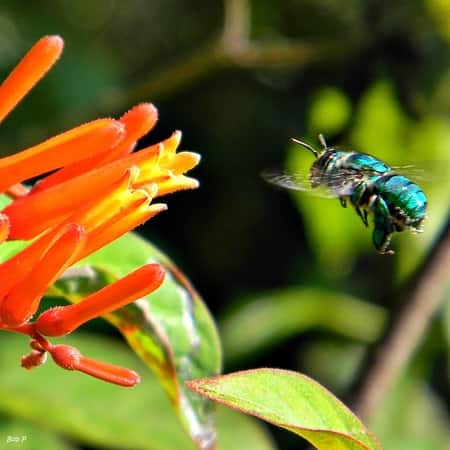
Not All Orchids Have a Nice Aroma, or One at All
Not all orchids produce a lovely perfume. Orchids that attract flies will produce a foul odor, similar to rotting trash. This orchid doesn’t want any pollinator, but is uniquely interested in attracting flies and gnats. If any other insect would come, pick up the pollen and land on a genetically different species of orchid, the chances of producing a flower would be slim.
Most big box orchids you can find in supermarkets aren’t fragrant at all, and have been cross-pollinated to create hybrids. They’re placed in visually appealing places at huge supermarkets and grocery stores.
To create a profit, vendors have enhanced the blossoming time, the size of the flowers, and have spent less time creating hybrids that have an amazing aroma. This is because in a supermarket, the smell will be the least of the items that incites you to buy it.
To get some of the orchids below, you’ll have to go to orchid nurseries, greenhouses, or purchase them online. If you know of any other orchids that are not on this list, please feel free to add them in the comments and describe a little of how they smell.
The characteristics of the pollinator also determine the times the blossom is open, varying from days to seasons. Some pollinators are night creatures, like moths. Others are more daytime animals, like butterflies. When the pollinator is the most active, is the time the orchid will produce its blossoms.
Again, since there are over 25,000 types of orchids, the chances to pollinate are very slim. The orchid has to do it’s best to attract the right pollinator and guarantee that the next flower it lands on will also be of the same species.
Types of Scents and Smells Are Personal
Below is a list of the top most fragrant orchids, listed in alphabetical order, from A to Z. This list is by no means complete or extensive. If you want a more thorough list, check out this PDF published by the Canadian Orchid Congress. It has 97 pages of orchids listed and categorized by name, scent, status of fragrance, strength of fragrance, type of fragrance and the time of day when the fragrance is the strongest.
It has 97 pages of orchids listed and categorized by name, scent, status of fragrance, strength of fragrance, type of fragrance and the time of day when the fragrance is the strongest.
This article is my future “to-buy” list, which I’ve selected some of the best fragrances (for me). Each person has a particular taste and is attracted to certain smells, so the best suggestion would be to go to orchid shows and specialized greenhouses and start “sniffing”.
Top 18 Fragrant Orchids and Their Scents
What are the best fragrant orchids, ranked for perfume?
When it comes to purchasing orchids for aroma, look for: Aeranthes grandalena, Brassavola nodosa, Cattleya walkeriana, Cycnoches Wine Delight, Cymbidium Golden Elf, Dendrobium kingiaum, Encyclia cordigera, Maxillara tenuiflolia, Miltoniospsis Herr Alexander, Miltoniopsis santanaei, Neofinetia falcata, Oncidium ornithorrhychium or sotoanum, Oncidium Sharry Baby, Oncidium Twinkle Fantasy, Phalaenopsis violacea, Phragmepedium schlimii , Rhynchostylis gigantea or The Foxtail Orchid, Vanilla planifolia, and Zygopetalum.
Not all of these orchids are easy to grow. In this article, I’ll give a very quick overview of the growing conditions, a brief story if applicable, and what to look out for if you are a beginner.
The table below shows summarized orchid scents:
| Orchid Name | My Try at Describing the Scent |
| Aeranthes grandalena | Jasmine, caramel, butterscotch |
| Brassavola nodosa | Super strong Lily of the valley |
| Cattleya walkeriana | Soft rose with a touch of cinammon |
| Cycnoches Wine Delight | Spice, mint, pepper and a dash of sugar |
Cymbidium Golden Elf | Light citrus, almost lemony |
| Dendrobium kingiaum | Clover, honey, or baby powder |
| Encyclia cordigera | Chocolate, honey and vanilla |
| Maxillaria tenuifolia | Coconut, Pina Colada |
| Miltoniopsis Herr Alexander | Soft honey, almost like gardenias |
Miltoniopsis santanaei | Rose petals, delicate French perfume |
Neofinetia falcata | Jasmine with a touch of vanilla |
| Oncidium sotoanum | Wine, baby powder, and cinammon |
Oncidium Sharry Baby | Chocolate |
| Oncidium Twinkle Fantasy | Spicy vanilla with tons of sugar |
Phalaenopsis violacea | Rosy floral with a hint of cinammon |
Phragmepedium schlimiicherry, | raspberry, strawberry mix |
Rhynchostylis Gigantea | Strong spicy citrus |
Vanilla planifolia | Vanilla ZygopetalumHyacinth, jasmine, baby powder |
| Zygopetalum | Hyacinth, jasmine, baby powder |
AERANTHES GRANDALENA
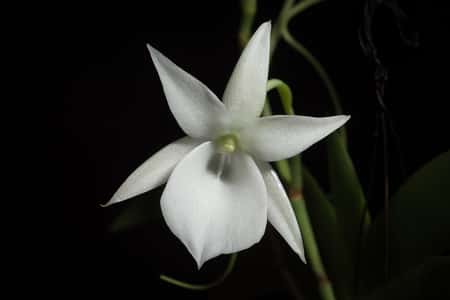
This was a hybrid of two wonderful frangrant parents, Angraesum magdalenae (which smells a lot like jasmine) and Aeranthes grandifloras (which has a fragrance similar to caramel or butterscotch). The Areanthes grandalena has a softer smell of jasmine, with a touch of sweetness to it.
These pale-white orchids with soft green tint in the 3-inch (7.5 cm) blossoms have deep, darker leaves. The play on the green tones is fascinating, which is a contrast to the light green leaf that is usually found in orchids.
The fragrance can be both day and night, but stronger at night. They rebloom constantly, so these are definitely ones to not cut the flower spike. They light medium-warm temperatures and low lights.
BRASSAVOLA NODOSA
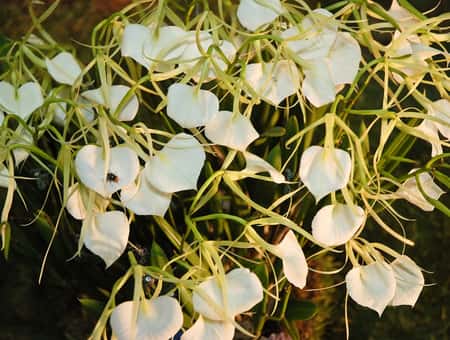
The Brassaavola are more commonly referred to as “Lady of the Night” since their perfume, similar to lily of the valley, is significantly stronger at night.
Instead of one or two flower spikes, like Cattleyas of Phalaenopsis, the Brassavola nodosa orchid will have cluster of small pearl white flowers that attract the white moth. Since this white moth is a night creature, the perfume that Brassavola nodosa sends out is bewitching, in an extremely positive way.
I don’t recommend having more than one of these indoors, since they do have a strong aroma. Just like a handsome man who’s cologne is so strong it makes it hard to breathe, the Brassavola is beautifully attractive, yet sometimes repels with its overly-powerful, strong scent.
The American Orchid Society has a culture page on this orchid that is worth reading.
has a culture page on this orchid that is worth reading.
The Brassavola orchid is a fairly easy to grow orchid, since it doesn’t like to be watered as much as other genera.
They do extremely well as mounted orchids or in hanging baskets. These are one of the high-light orchids, which will do well from 2500 fc to 4000 fc, and one of the few that can tolerate direct sunlight. Because it likes high light, it’s also considered a warm-temperature orchid, blooming more in summer.
It’s considered a beginner’s orchid, and the scent is one of the most engraving in my memory as a child. The night school I went to had a Brassavola which grew into what looked like a small bush or tree. Walking past it each night made you pause your step, close your eyes, inhale deeply, and rethink the blessing through the day.
This is one orchid I currently don’t have because of my poor lighting conditions, but am anxious to grow—just for wonderful the memories.
CATTLEYA WALKERIANA
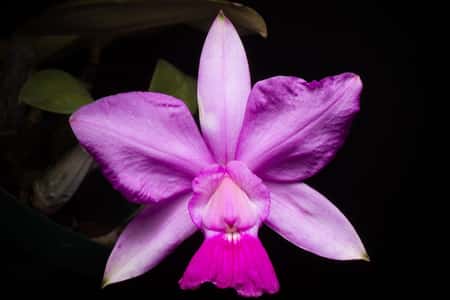
Cattleyas orchids are known for their scent, which is more notable than most big box orchids we find, like Phalaenopsis, which hardly has an aroma at all. One of the Cattleyas that most strikes our attention is the Walkeriana, which portrays big, purplish-pink, luscious flowers. When I say big, I mean 4 ½ inches wide (12cm). They flower in April and stay in bloom for about a month
The Cattleya walkeriana orchid is called “Queen of the Brazilian Savannah”, native to the central plateaus in Brazil, a region I’m quite familiar with. Check my bio here, if you’re curious as to why.
In this part of Brazil it gets extremely hot and not as humid as I’d like. The days can be drawn out and intolerably dry. To grow a Cattleya Walkeriana at home, you’ll have to move it away from the humidifier and use a potting medium that drains out extremely quickly.
This full sun, high light, high temperature orchid is a bit tricky to grow indoors, but it can be done because it’s highly adaptable. It’s so adaptable that this fame of this orchid has crossed the globe and has found admirers in Japan.
There are whole fan clubs organized around the Cattleya Walkeriana, and a book that was written about just this species. You can read more in this book review (since I haven’t bought the book, I can’t recommend it personally. I only recommend things I buy and test out, which you can see on my resource page.)
(since I haven’t bought the book, I can’t recommend it personally. I only recommend things I buy and test out, which you can see on my resource page.)
The fragrance of this particular Cattleya is of a rose, but more like the scent of a diluted French perfume that was made with roses. Some say it’s more towards cinnamon and vanilla. The scent will be stronger in the early morning and tend to fade towards the end of the day.
CYCNOCHES WINE DELIGHT

CYCNOCHES WINE DELIGHT
The deep red color in the flowers imitate red wine, but the smell isn’t what the name suggests. These orchids from the Catasetum genus move away from the chocolate, vanilla, sweeter smell and move closer towards the spicier aromas. A mixture of spice, mint, and pepper added with a dash of sugar would be my explanation. The strong cherry fragrance is more noticeable in the morning, fading away during the day.
Each Cycnoches Wine Delight Orchid will have 7 to 10 flowers on each flowers spike and prefer sun for some period of the day. Being high-light orchids, Cycnoches Wine Delight will have lighter yellowish-green leaves, instead of the normal green we usually see in orchids. They also will prefer to be in this light for up to 16 hours a day.
Along with the high-light requirements, Cycnoches orchids love to have higher humidity than Phalaenopsis or Cattleyas, at a minimum of 60%.
These orchids will go into a dormant period where all of most all the leaves fall off, and that is the only reason I don’t have one of these. I always panic when I see this “half-dead orchid” and it’s so bothersome, I can’t keep Catasetums.
I know they’re not dead, but it’s still extremely upsetting (for me). I’m the get-up-and -go personality, so watching this orchid just sit there, moping around in agony and crippling depression until it produces new roots is definitely not my thing.
CYMBIDIUM GOLDEN ELF
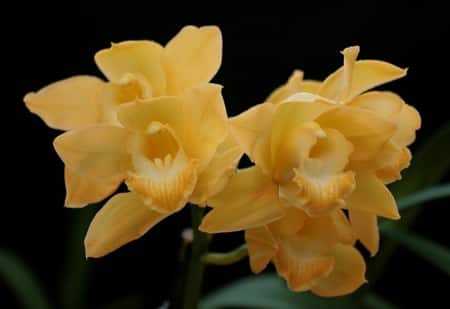
(Note, this picture is of a slightly different Cymbidium. I couldn’t find an image of the Golden Elf)
CYMBIDIUM GOLDEN ELF
This orchid will bloom from spring to fall, but mostly in late August or early September and the deep, vibrant yellow color gives off a hint of a light-citrus flavor, almost like a lemon smell. You can smell these orchids from almost a foot away. It’s not as strong as the Brassavola Nodosa (I don’t think any of the rest are as strong for that matter) and you have to move closer to really appreciate its scent.
The Cymbidium Golden Elf loves to be in light, just like the first few, and can tolerate hotter temperatures. Unlike the first two, this one does NOT like to be dry during watering, so you have to keep the potting medium moist.
It will bloom twice a year if the pot is the right size, as it likes to be root-bound. So don’t worry about repotting so soon. If you grow Cattleyas, you can place them in the same light conditions, but add a little extra heat.
The Napa Valley Orchid Society has an interesting culture sheet about The Cymbidium Golden Elf, and if you read the comments, you can find pertinent growing tips from other orchid hobbyists. It is one of the easier Cymbidiums to grow, given you keep the potting medium moist, keep it in high light, and raise the temperatures indoors.
has an interesting culture sheet about The Cymbidium Golden Elf, and if you read the comments, you can find pertinent growing tips from other orchid hobbyists. It is one of the easier Cymbidiums to grow, given you keep the potting medium moist, keep it in high light, and raise the temperatures indoors.
DENDROBIUM KINGIANUM
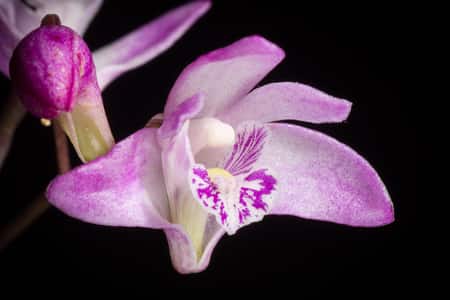
DENDROBIUM KINGIANUM
These slight shades of pink magenta dendrobiums are native to Australia, and have so many different common names it’s crazy: Thelychiton kingianus, Captain King’s dendrobium, Pink rock orchid, the easiest plant ever, and many more. These orchids, unlike the others listed in this article, are mainly rock lovers. They squeeze into the crevices of rocks and “feed” on dead leaf litter.
To imitate these conditions, a potting medium with woodchips and charcoal would be the best medium.
They live in almost desert-like conditions, and they can do well with little humidity and high light and high temperatures. Their roots not only absorb the little humidity that is in the air, they also reflect he white light, cooling the orchid down when it’s too hot.
Even thought they can survive in those kinds of climates doesn’t mean they like to. If you can provide 50% humidity, your Dendrobium Kingianum will thank you with amazing flowers. But that’s not all they need: a decent temperature drop at night is absolutely necessary for these orchids.
Each pseudobulb will produce 3 to 6 leaves, and each flower spike will have 2 to 15 flowers each. The scent that these flowers produce is like sweet clover, hyacinth with a mixture of dark wild flower honey, or a powdery smell. This orchid has mixed feelings when most people smell it: it can either smell of medicine or of hyacinths.
Either way, be careful, because they are powerful. They are very overwhelming, even when in bud, during the morning hours, (almost overbearing when fully blossomed) and fade away toward nightfall.
ENCYCLIA CORDIGERA
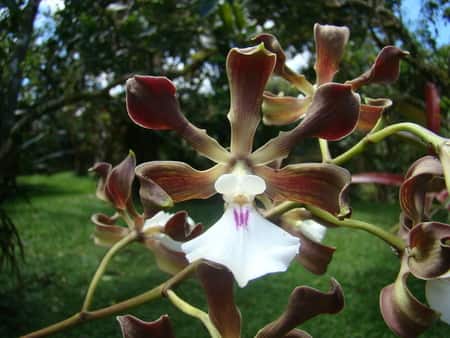
Encyclia Cordigera are another orchid that share the chocolate, honey, and vanilla scent. They are grown naturally in Central American, from Panama all the way down to the northern tip of Brazil. These high light orchids will thrive on constant watering, and the number one thing that hinders them is that growers tend to think they are like Cattleyas.
They are in a light-sense, but they need much more water, In fact, if you want to keep a sphagnum moss medium or semi-hydroponics, they grow a lot better.
The Encyclia have over time been mislabeled and placed in the Oncidium, Cymbidium, and Epidendrum genera. It was only in 1964 that the current classification ‘discovered” the mistake, from when it was first named in 1815. The Cordigera are probably the most known species in the genus, due to the fact of the size and fragrance of its flower.
The pseudobulbs look like little onions when well-watered, which makes them very distinct. When in bloom, these orchids will stay open for a little over a month.
As for the aroma, this one imitates roses, but the smell varies slightly from plant to plant. Some have described it as a chocolatey smell, but I can’t smell that personally. If grown in direct sunlight, the scent will be more powerful, as this orchid liberates the pheromones as temperature rises.
Not wanting another chocolate orchid? Try the Encyclia Serena O’Neil, which smells a lot like passion-fruit. The Encyclia Alata has a more tropical scent, with it’s mix of coconuts and vanilla.
MAXILLARIA TENUIFOLIA
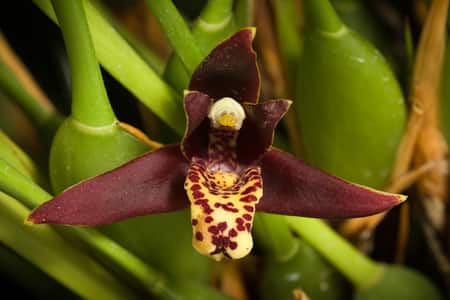
This “little” orchid is a must-have to any orchid collection. I say little because the small flower, 1 ½ to 2 inched (3.5 to 5cm) but the leaves are a massive display of life. Even without flowers, this orchid makes a beautiful houseplant, with its long slender leaves and odd-shaped pseudobulbs. Just by themselves, they make a statement…but when they are in blossom, they captivate any spectator. Tiny delicate flowers emerge from the bottom base next to the pseudobulb. Even though they are minute, they’re massive in their aroma.
The scent of coconut or Pina Colada soon moves through the room, and you almost feel as if you’re in Hawaii. Actually, the common name for these orchids is The Coconut Orchid. The amazing fragrance transports you to other nations, far, far away. Maxillaria Tenuifolia orchids are native to Mexico, Guatemala, Belize, El Salvador and Nicaragua, and by the smell, they quickly picked up the festive Latino way of life to enhance ours.
The flowers on the Maxillaria Tenuifolia will bloom around March or April. Since these orchids like to have their roots moister than others, when potting, add a considerable amount of sphagnum moss. If you grow Cattleyas, these will love the same conditions. Except every time you water a Cattleya, water the Maxillaria twice as much.
The interesting thing about Maxillaria Tenuifolia is that the size of the pot will determine the shape of the plant. If you have a wider pot, then the pseudobulbs will spread out and the leaves will be shorter. If your plant is rootbound, in desperate need of a repot, the pseudobulbs will grow almost on top of each other, forming a uniquely interesting design. The leaves will grow more upright, giving a more elongated feel to the plant.
MILTONIOPSIS HERR ALEXANDER
I could not find a free image of Herr Alexander that didn’t have copyright restraints, but this one is a Miltonoipsis. So please check other images.
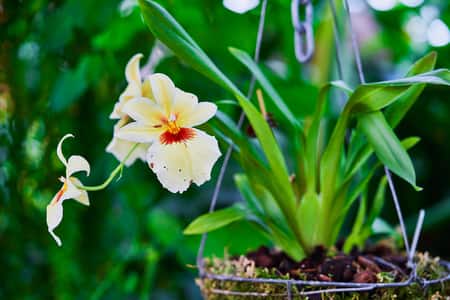
Militoniopsis orchids have the fame of smelling like rhubarb pie, but the Herr Alexander species has come to change that. These have a more honey scented flower, similar to gardenias. The scent is only active during the noon to early afternoon hours, when the sun is brightest. Even still, the fragrance isn’t overpowering and won’t fill up a room.
Militoniopsis mainly like to be kept in a moister cool environment, and are one of the few orchids that do well in pure sphagnum moss (besides seedlings.) The hardest part about growing them is getting the lower temperatures indoors, that they prefer. Grow lights are excellent, because they can provide the high light requirements without raising the thermometer.
These orchids are originally from Colombia and Peru, and bloom later than most: mid-August to late September. The genus name comes from a botanist in the 1800’s, Fitzwilliam Milton, but is commonly known as the pansy orchid.
MILTONIOPSIS SANTANAEI
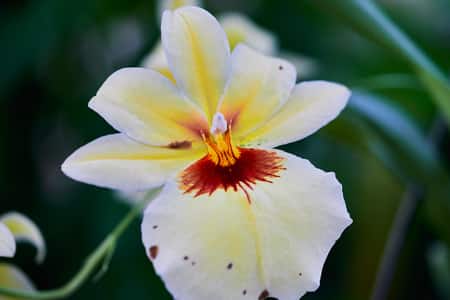
These orchids look like little pansies, but their smell is more of a rose scent. These orchids had in the past a bad reputation of being hard to grow, and because of this, they have fallen down in popularity ranking. But once you get down their habits and preferences, Miltoniopsis grow like weeds.
The trick in growing these orchids is that they require the higher temperatures but not as much light. So while they can sit with your Cattleyas in the temperature zones, they won’t tolerate the same light requirements. They prefer 900 to 1000 fc, which is extremely low, and not many orchids thrive in such low-light. They don’t do well with cooler growing orchids, either, since most cooler growing orchids like Odontoglossum, prefer to have less light. So it’s an unusual combination.
On the American Orchid Society page , there are several other Miltoniopsis and their lighting, humidity, and growing conditions. These orchids mainly grow in Brazil, Colombia and Ecuador. If you are a big fan of these orchids, you might want to read the newsletter put out by the Odontoalliance,
, there are several other Miltoniopsis and their lighting, humidity, and growing conditions. These orchids mainly grow in Brazil, Colombia and Ecuador. If you are a big fan of these orchids, you might want to read the newsletter put out by the Odontoalliance,  which has 10 pages of specialized care tips.
which has 10 pages of specialized care tips.
It’s worth checking it out, but be sure to get the satanaei species when looking for aroma.
NEOFINETIA FALCATA
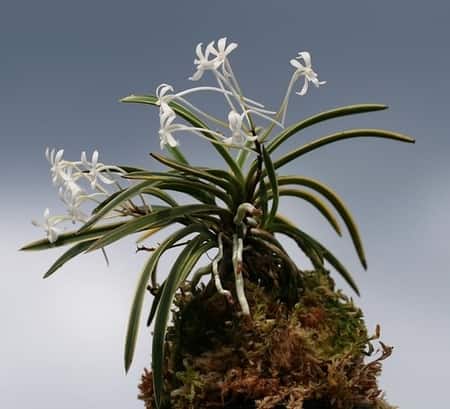
This orchid, called Orchid of the Shoguns, has history to go with it, which in my opinion, makes me fall in love with the orchid even more. Neofinetia Falcata is a common houseplant orchid grown in Japan, and dates as early as the 1600’s.
Tradition has it that the Japanese Samurai, Shogun Tokugawa Lenari, would carry one on him during battle as a sign of good luck. He would then search for them in the mountainous regions of Japan, and the habit soon spread throughout the army. The soldiers would set out to search for these orchids and present them to Tokugawa in return for special favors.
Needless to say, these orchids are native to Japan, Korea, and China. They grow in lower-light temperatures, preferring bright shade and no direct sun. This makes the optimal to make into floral designs, and their leaves favor it too.
The leaves look amazingly similar to Vandas, but a mini-version of the large flower. That is why recently, the Neofinetia genus has be regrouped and is now a Vanda. Since these are considered miniature plants, they are perfect for growers with not much room (like me).
These orchids are perfect to make into Kokedamas, which is a Japanese method of moss warping the roots, forming a neat, little designs with the root ball. I’ve made a tutorial, teaching step by step of how to make a Kokedama. If you’ve never tired one, this is the place to start.
They certainly are for beginner growers, since they can tolerate the most extreme temperatures. Some of these orchids will tolerate a light frost, and yet continue to grow in hotter summer days. Well, let me rephrase the extreme part: they tolerate the amplest range of temperatures from high to low, but grow the best around the 70ᵒ F (20ᵒ C).
This orchid mixes the delicate jasmine scent with a touch of vanilla. Some say it has a smell of citrus coconut. I guess it depends on who you buy it from and how each plant grows with light, temperatures, humidity and other minor details.
ONCIDIUM ORNITHORHYNCHIUM OR SOTOANUM
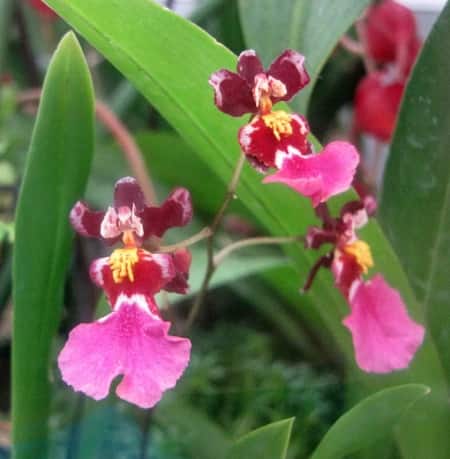
ONCIDIUM ORNITHORHYNCHIUM OR SOTOANUM
This Oncidium is not only special for its sweet fragrance of cinnamon and vanilla, but because of it’s hundreds of angelic-like flowers that blossom all at once. Originally, these orchids were described as tiny birds with long beaks from Central Mexico in the 1800’s.
Later, records proved that they were mistaken, and the Ornithorrhychium was thought to be an Oncidium pyramidale. Described as the wrong plant, this Oncidium was (now) originally from closer to the equator: Ecuador, Colombia, and Peru. No matter where it’s from, it’s beautiful, and fragrant!
During the morning, these Oncidiums produce a stronger scent, resembling a grape, or wine. As the sun fades away, the scent changes to a more relaxed scent, similar to baby powder with a touch of cinnamon.
Event though the flowers of this Oncidium are minuscule, the plant itself is not. Each flower spike can hold hundreds of blossoms, making the pink angelic flowers truly amazing. These are stand alone flowers, perfect for living room tables, behind the couch centerpieces, stand-alone plant stands and other displays that place the focus entirely on them.
This is the mother plant of the Oncydium Twinkle, that we’ll talk about below.
ONCIDIUM SHARRY BABY
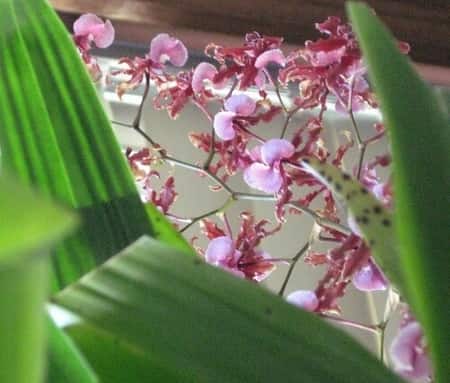
ONCIDIUM SHARRY BABY
If you’ve ever researched orchid scents on the internet, this would probably be the first orchid to appear in the search results. The unique smell of chocolate (some say it leans more towards a honey, vanilla, milk chocolate, candy, or vanilla chocolate scent) will for sure entice you.
These dark purple flowers with hints of yellowish-brown speckles grow in masses on the flower spike. The pseudobulbs sit tightly in the pot, and don’t grow over 4 inches high (10 cm).
These orchids can tolerate and actually prefer brighter light than your Phalaenopsis. Since these orchids like to dry out, they are perfect for mounting on tress outside or in hanging baskets. Since they like aeration, terracotta pots are perfect. Use a course to medium grade bark, but water almost every day if in a hanging basket.
To get a good idea of how much water your Oncidium needs, always keep an eye out for the pseudobulbs. Wrinkled bulbs mean your orchid is suffering and could use a drink (or two).
ONCIDIUM TWINKLE FANTASY
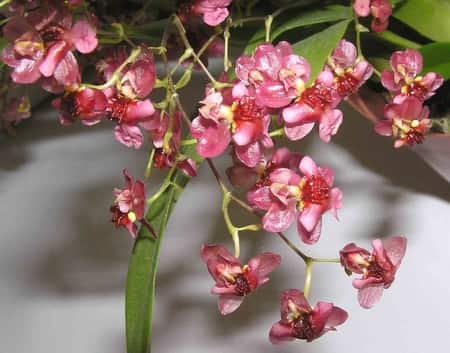
ONCIDIUM TWINKLE FANTASY
Oncidium Twinkle Fragrance Fantasy, a relatively new hybrid dating from 1958 in Hawaii, is a cross between the Oncidium I mentioned earlier and another fragrant Oncidium, the Oncidium cheirophorum. The result was the Twinkle Fantasy, that also has a wonderfully strong scent, compared to spicy vanilla with extra, extra sugar.
These aren’t hard to grow, but the do take a long time to flower. You’ll see the flower spike emerge, but it will literally take months for it to reach full height and actually blossom. These tiny flowers blossom in the thousands… and can have nearly 20 flower spikes on an adult plant at any one given time. So even though they are tiny, they are mightily fierce.
The main problem with these plants is the idea you have to repot every so often. Twinkle Fantasy hate to be repotted, and if they could stay root bound forever, they would.
Remember, these are miniatures, and an adult shouldn’t ever go over a three-inch pot.
They do quite well indoors, since they don’t tolerate any kind of sun, falling into the low-light category. So use a sheer curtain by the window when placing them on the sill.
PHALAENOPSIS VIOLACEA
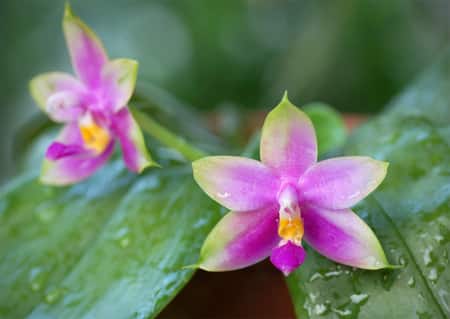
Finally, a Phalaenopsis! I’ve been waiting eagerly to get to this one. Not because of its smell, but because this is one of the first orchids many people own, and it makes them hooked on orchids forever—so hat’s off for the Phals. Sadly, violaceas aren’t in the big box growers list most times, since this orchid is so different from teh common Phal.
This tiny beautiful orchid is said to emit a spicy cinnamon smell.
These orchids originally form Malaysia and Philippines, are more purple and a little more pointed on the ends than the “normal” big-box Phal. The charm is their purplish-red colored flowers, which are a striking contrast to the leaves. Their leaves are also a bit lighter green shade, growing closer to yellow. They thrive under the same growing conditions as Phals do.
They have a scented cinnamon smell to them mixed in with a rosy-floral, and aren’t overpowering at all.
PHRAGMEPEDIUM SCHLIMII
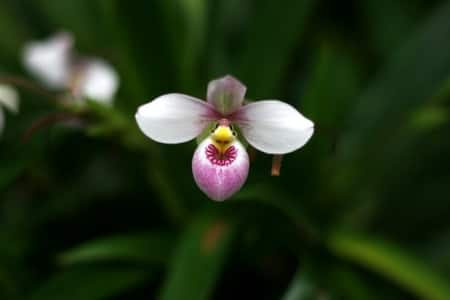
PHRAGMEPEDIUM SCHLIMII
These smaller sized orchids have a Paphiopedilum look to them, but in a miniature version. They carry a rose-petal-almost-berry like smell, but it’s not strong. This is actually one of the best scented orchids to be growing indoors in my opinion. Yet, to really make a difference aroma-wise in your house or bedroom, you’d have to get about six or seven (or maybe sixteen or seventeen).
They grow in moist, humid environments in Columbia, averaging 70% rH—a higher relative humidity than most beginner orchids, like Cattleyas. Don’t keep the roots soggy or overly wet, but they do like to stay humid. If they grow outside, you should water them 2-3 times a week.
They like lower light, anywhere from 1000 fc to 1400 fc, right along with the Phalaenopsis orchids. (*Note: there was one article which claimed that Phragmepediums like higher lights, around 2000 to 3000 fc, so I’ll leave this one up to the reader. Even though I tend to drift toward higher lighting, too.)
Temperatures on these orchids range from 58ᵒF to 68ᵒF (14ᵒ C to 20ᵒ C).
They bloom almost year-round, except in winter and can come in pink, purple and yellow tones on a flower spike that stands 12 inches tall (30cm). This is why they aren’t considered miniatures, but medium sized orchids. When I researched these orchids, the literature suggests that each flower spike can have 6 to 10 blossoms, but I’ve always encountered less, mainly one or two.
These orchids grow on rocks, stones or pebbles, and are called lithophytes. They also can be terrestrial, so potting medium will have to be differentiated for these orchids. They can usually be found growing on rocks next to rivers, where humidity is high, yet shaded by the forest trees.
RHYNCHOSTYLIS GIGANTEA OR THE FOXTAIL ORCHID
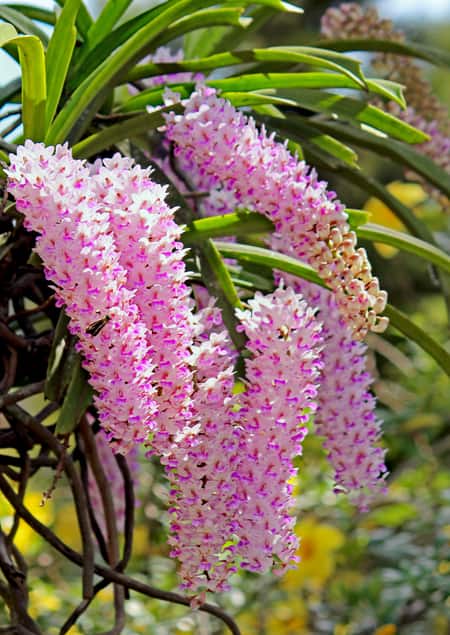
RHYNCHOSTYLIS GIGANTEA OR THE FOXTAIL ORCHID
These orchids are a spectacle even without the fragrance. The fox-tail look, with bushy flowers blossoming in every direction on the flower spike give this orchid a special place on the orchid shelf.
You can purchase these to either bloom in the winter or in thesummer.
The Rhynchostylis gigantea is native of Southeast Asia, engulfing countries like Myanmar, Laos, Vietnam, Thailand and many others. The climate in these countries is humid and warm, so replicate that when growing these orchids.
This means that you’ll be aiming for intermediate light, from 2000 to 2500 fc (a little lower than Vandas but more than Cattleyas). There are growers that prefer to use less light, and grow them with the Phalaenopsis rack, as low-light orchids. In any other circumstance, a flower spike would not appear, but not with the Fox Tail orchid.
These orchids do like to stay a bit more humid than Phals and Cattleyas do, so you’ll need to water them more often. When it comes to repotting (which could be longer than 2 years for this orchid, usually around three to 4) you’ll need to really soak this orchid’s roots. They tend to cling to the pot and are really hard to get out.
With 15 to 50 flowers on each flower spike, the fragrance is similar to spicy citrus and kind of strong. Air movement is good to keep this orchid from overpowering a room, and also because of the constant watering requirements.
VANILLA PLANIFOLIA
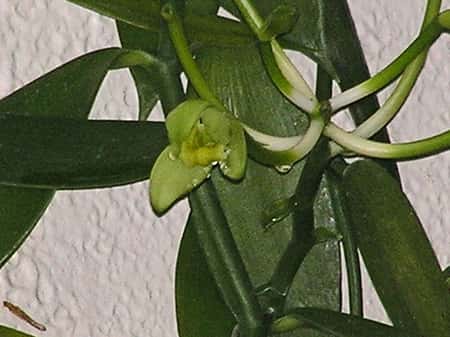
This orchid would smell like vanilla, obviously, since it is the vanilla plant. I wrote an extensive article on growing the vanilla orchid here, and since I don’t want to repeat myself, I just limit myself to saying that these are a lot of work if your aim to get the vanilla bean. It always looks great on paper, but once you move past the theory, hmm…. No comments.
ZYGOPETALUM
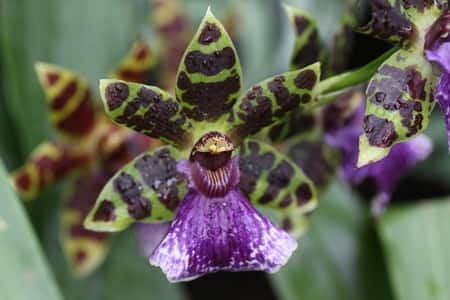
ZYGOPETALUM
And our last but not least, the Zygopetalum. If you noticed, I didn’t include a species here because all the 15 species the Zygopetalums have some sort of scent associated to them. They could be hyacinths, baby powder, or jasmine… But each one will have a specific scent, either stronger or softer.
These epithets truly love to be in hanging baskets or mounted on slabs, since they don’t like to be inside a pot. Native to Bolivia, Argentina, Brazil, and Peru, Zygopetalums have pseudobulbs which mean they can store water better than they can tolerate being in a soggy, wet potting medium.
These are definitely not small plants. Their leaves grow up to 2 feet long (60 cm) and they prefer bright indirect light for longer periods, from 14 to 16 hours a day. They also like a rH of 50%, so humidity trays or humidifiers are not negotiable if you want to grow them successfully.
A to Z, literally… Aeranthes grandalena to Zygopetalum
Don’t Stop Learning!
If you want to be included in more information and get a 14-page fertilization guide, please sign up for my newsletter. I don’t spam, but send emails out bi-monthly with some curious topics of interest. If you want more information, click here to go to a specific page on this website where I explain it more in detail.

Also, if you are looking for an orchid journal to keep your notes specifically about orchid care, check out my 2 solutions for that on this page. If note-keeping isn’t your thing, then there is a free excel spreadsheet that you can download. Click here for more information on how to do that.
If you subscribe to my newsletter, I will send you a 14-page guide on the main tips of orchid fertilizer. It is downloadable and you can print it out on your computer. I designed the guide to double up as a coloring book, just to make it fun.
And that concludes my list of orchids that I have in mind to buy based on scent. If you have some other ideas of orchids that should be included in this list, please list them below and please, describe their scent!
Happy Cultivating!


Such a fantastic amount of equally fascinating information about Orchids! Feel mesmerized by them! Will forever want to smell each one my eyes touch upon! Truly are a wonderment to behold!
Hi Florence,
Thank you for the comment! 🙂 Orchids are amazing, aren’t they?
-Amanda
Lc.Mini Purple coerulea
– the strong aroma of lilac and Lily of the valley.
I just bought a less commonly known Orchid – Cattleya Rlc Patchara Fancy as my first orchid. Its supposed to have a nice ‘Cattleya’ fragrance. I was thinking of buying a Brassavola as my first orchid, but ended up getting the Patchara. I have no idea what a ‘Cattleya’ fragrance is supposed to smell like. Will find out when it blooms.
Hi Manmohan, Usually Cattleya are very fragrant. Brassavola are extremely fragrant, almost to the extreme, but harder to grow (depending on your conditions).
-Amanda
G’day Amanda from Australia. Thank you so much for the info. One of my favorites is Dendrobium anosmum a cane orchid that has the most sweetest smelling flowers resembling that of rasberries, hence its common name rasberry jam orchid. On a still morning the whole garden smells of this orchid. Gorgeous dark pink/purple flowers usually about 15-20 blooms per cane(there is also a white form with the same perfume). An interesting observation was the presence of fruit fly! No noticeable damage, possible pollinator? One last comment after reading the previous ones, there are a number generic hybrids one in particular is BLC(BrassiaLaeliaCattleya)nearly all of which have amazing perfumes. And flowers of course
Hi Graeme, Thank you so much for your comment! I appreciate it!.
Hi there, I have been looking for this orchid that you described smelling like raspberry. I had one, a beautiful mature Orchid as you described with beautiful pink purplish flowers that smelled like heaven, it was gifted to my husband by a co-worker. Unfortunately, it was knocked out of the tree and then run over by our lawn mowing people. That was bad enough but they then discarded every last piece of my gorgeous orchid, not a trace of it anywhere. Ive never gotten over it!…I live in Florida, where can I find this plant?
Hi Amanda, Excellent information. I had an Oncidium Sharry Baby years ago and have not seem it for sale any more.
I do have photos of Cymbidium Golden Elf so you can post on your site.
Blessings,
Emee
Sharry Babys are still quite popular, if you look online I would be surprised if you aren’t able to find it, I just did a search and found a few quite bit of them from reputable vendors.
Hi there,
I live in Fl and a cpl of years ago I drove by a couples home who happened to have a garden and backyard full of different orchids. They happen to be selling a few for Mother’s Day so I got one for my mom and another for myself. I happened to keep the Maxillaria tenuifolia (coconut orchid) and it was the first time I came across an orchid that had any kind of scent. Truly a wonderful surprise. After reading your article, I must get another with one of those delicious scents you describe. Which one is your favorite?
I’ve always found my Sydney Rock Orchid (d. speciosum) to be more highly perfumed than the Pink Rock Orchid (d. kinganum). But I guess they are all highly variable!
Excellent job Amanda!
I enjoy ready your posts.
Bless you and yours.
Correction, Reading your posts.
Was this inspired by, or written after I contacted you pleading for helping with the scent that wafted out from the orchid tree (which is likely not even in the orchid family to begin with, but rather named that because of the look of its blooms)? I hope so!! I am so impressed with your scope of knowledge, and was thrilled to come across your work again <3 Thank you for this helpful, and informative article, Amanda!! Sincerely, Lily
Great information shared.. really enjoyed reading this post thank you author for sharing this post .. appreciated
I like the efforts you have put in this, regards for all the great content.
Nice post. I learn something totally new and challenging on websites
Awesome! Its genuinely remarkable post, I have got much clear idea regarding from this post
I like the efforts you have put in this, regards for all the great content.
Great information shared.. really enjoyed reading this post thank you author for sharing this post .. appreciated
This is my first time pay a quick visit at here and i am really happy to read everthing at one place
Nice post. I learn something totally new and challenging on websites
I appreciate you sharing this blog post. Thanks Again. Cool.